#moroccan tajine
Photo

Khadija is in the Kitchen: It's baking and cooking time!! turned 9 today!
https://khadijaisinthekitchen.blogspot.com/
#tumblr birthday#tumblr milestone#blog#blog birthday#cakes#cookies#moroccan cuisine#moroccan tajine#morrocan food#yummy food#yummyeats
0 notes
Text

[ID: A large bowl filled with several chicken breasts covered in an herb marinade, dark green olives, and pale yellow lemon wedges. End ID.]
Vegan tajine djaj b zitoun / طاجين الدجاج بالزيتون (Moroccan chicken stew with olives and preserved lemon)
This tajine features chicken flavored with chermoula--a Moroccan marinade primarily consisting of cilantro and parsley (in ratios anywhere from 1:1 to 4:1) but also inclusive of garlic, spices, chili pepper, garlic, and lemon, depending on region and personal preference. The chicken is then slow-cooked in olive oil and water to produce a thick, saucy stew; bitter olives and Moroccan preserved lemons add tanginess, salt, and color.
Recipe under the cut!
Patreon | Tip jar
INGREDIENTS:
For the marinade:
~ 300g unseasoned, unbreaded vegan chicken breast (I used Gardein)
2-inch chunk cassia cinnamon, or 1/2 tsp ground cinnamon
1/2 tsp black peppercorns, or ground black pepper
1/2 tsp sweet paprika
1/2 tsp ground ginger
1/2 tsp ground turmeric
1/2 tsp cumin seeds, or ground cumin
1 small bouquet parsley
1 small bouquet cilantro
pulp of 1 preserved lemon*
1 clove garlic
1 Tbsp olive oil
1/2 cup water
pinch of saffron
*Moroccan preserved lemons are simply a Moroccan variety of lemon preserved in saltwater. They may be found in halaal grocery stores; Mina is a brand that I've seen in western grocery stores in the U.S.. I've also used Thai preserved lemons from an Asian grocery store in a pinch.
For the dish:
1 Tbsp vegetarian chicken stock concentrate (or substitute soy sauce)
1/2 cup water (vegetable stock, if not using chicken stock)
Large handful of bitter green olives
1 preserved lemon, quartered
1 large yellow onion, chopped
1 Tbsp olive oil
salt to taste
INSTRUCTIONS:
1. If frozen, allow chicken to thaw in the refrigerator for several hours, or in a large bowl full of warm water, while you prepare the marinade.
2. Grind saffron to a fine powder in a mortar and pestle, or crumble it between your fingers. Soak it in 1/2 cup of just-boiled water for at least 10 minutes.
3. If using whole spices: heat a dry skillet over medium heat and toast cinnamon and black peppercorns for a few minutes until fragrant and a shade darker. Set aside. Toast cumin seeds for about a minute until fragrant and set aside. Remove the skillet from heat and toast ground spices, agitating constantly, for about 30 seconds.
4. Grind parsley and cilantro leaves to a paste in a mortar and pestle, or mince them and then crush them with the flat of a knife. Mash garlic and lemon pulp in a mortar and pestle, or grate the garlic and chop the lemon pulp.
5. Mix all marinade ingredients in a large bowl and rub marinade onto both sides of each chicken breast.
6. In a large pot, heat oil on medium high. Add onions and cook for 5-8 minutes until translucent; remove from the pan or push to the side.
7. Lower heat to medium and brown chicken on both sides (about 5 minutes each side). Mix in with onions.
8. Lower heat to low and add olives, lemon, and vegetable or chicken stock. Cook, partially covered, for about half an hour to allow flavors to incorporate and stock to thicken.
(Traditionally, tajine b djaj is cooked by heating oil in a tajine, then adding onions, chicken, and water and covering to allow the chicken to steam for several hours. The lemons and olives are then added later in the cooking time. I haven't found much of a point to doing this with vegetarian chicken substitutes; the texture does not improve with simmering, and the 'chicken' doesn't let out much flavor into the cooking water (which is why I've called for stock, rather than water, in this recipe)).
Serve warm with khobz. The flesh of the preserved lemons is eaten; the rinds are left.
262 notes
·
View notes
Text
So I was on the phone with my sisters and my father and I started getting out vegetables and meat to cook dinner and my Baba said "you're not going to make a tajine now?" (it was around 10.30pm). And I said "it's alright, it's not gonna take too long, I'm just throwing everything into the pan and letting it cook". And my Baba went full offended gasping "oh hell no, if you're going to make a tajine you're going to make it right and that takes at least 45 minutes!". So I said "uuuh, tell me again how it's made, because I think I'm missing something?..."
Turns out I've been making my tajines wrong all along, but now I know how to make them right, so I'll share with you.
Moroccan tajine (for 1 person) :
- onion and garlic to taste
- meat to taste (preferably lamb)
- 2 carrots
- 1 courgette (or half if it's a big one)
- 2 potatoes
- spices
To start:
Cut the onion in thin slices and the garlic roughly. Put them in the saucepan with a bit of water, just enough to cover them but not drown them.
Let them simmer for around 15 minutes, until the onion is melted.

In the meantime get the rest of your vegetables ready.
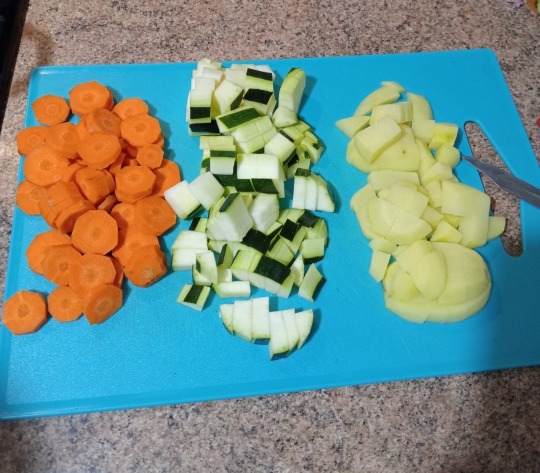
Once you deem the onion sufficiently translucid, add your meat (sorry, I don't know the timing for vegetarian equivalent meat).
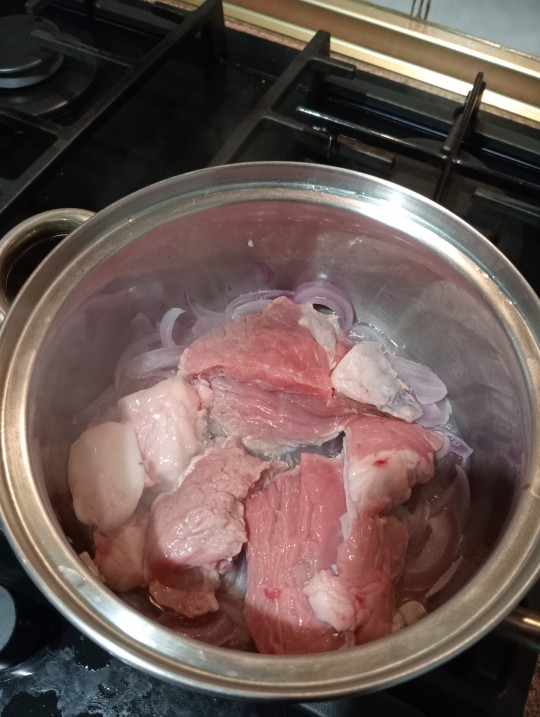
At this point, add your spices. I personally put the classics, salt, pepper and cumin (cumin is very important), and then I add paprika, ginger and rosemary.
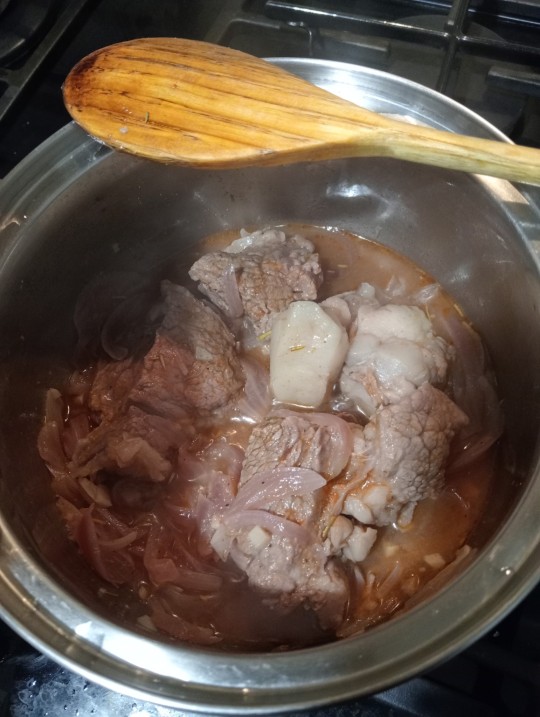
Let the meat cook for another 15 minutes or so and add the carrots. Carrots take a long time to cook so you add them before the rest.

Wait for another 20-25 minutes, cooking on slow burn and checking regularly the water. You don't want your sauce to evaporate. The water you add if necessary must be heated.
You can add the rest of your vegetables after 20 minutes, when the carrots are already starting to cook well.

And now you let it all cook gently and slowly until the vegetables are ready. Don't eat immediately, it's very hot! A traditional Moroccan tajine is usually cooked in a clay dish like this, so it's dangerously hot.

And that's it! Quite simple in the end, but it does take a hot minute.
26 notes
·
View notes
Text

21 notes
·
View notes
Text

Tajin
#tajin#morrocco#morocco#moroccan#marakech#marakesh#travel photo blog#travel photography#vacation#photoblog#tummy#photobugcommunity#travel#old town
5 notes
·
View notes
Text


#moroccan food#moroccan#morocco#tajine#tagine#swordfich#food#food log#foodblogger#foodporn#foodstagram
3 notes
·
View notes
Text
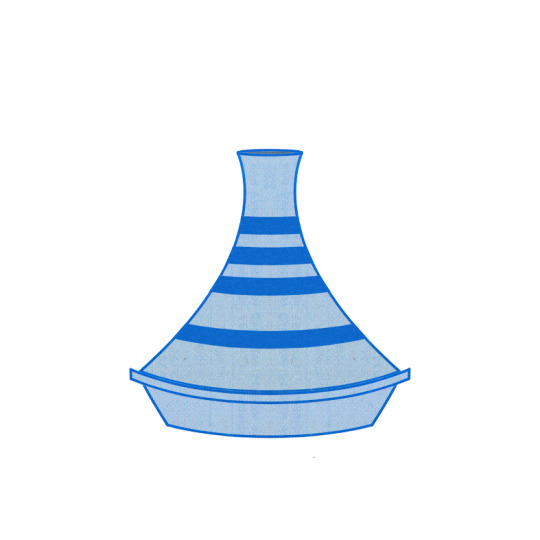
page 550 - If I haven't had an authentic tagine dish, I've certainly read about it.
I fell asleep moaning about peanuts as commodities and I wake up dreaming of hoarding stew. This place is getting to me.
Before I fell asleep I could have sworn I heard hissing. Gas piped into my face, sound from a cartoon.
#economics#economy#economist#graph#chart#nobel#typical age earnings profile#typical#profile#class#income#determinants#morocco#moroccan#tagine#traditional food#cooking#culinary#tajine#knockout#knockout gas#stew
4 notes
·
View notes
Photo

Do not forget to share a #tajine with your #moroccan #friends #couchsurfing (à Taghazout, Morocco تغازوت ، المغرب) https://www.instagram.com/p/CmuNkJmr0oO/?igshid=NGJjMDIxMWI=
0 notes
Photo

Tajine!! Different types of Tajine are there. This is vegetable Tajine. #morocco #marrakech #tajin #tajine #vegan #veg #foodphotography #foodie #foodlover #food #foodporn #instafood #foodie #foodlover #eat #yummy #yummyfood #goodvibes #food #africa #northafrica #marrakech🇲🇦 #moroccan #india #indonesia #china #like #travel #welcome #essaouira #essaouirabeach (at Essaouira, Morocco) https://www.instagram.com/p/ClRXxQ3qjVF/?igshid=NGJjMDIxMWI=
#morocco#marrakech#tajin#tajine#vegan#veg#foodphotography#foodie#foodlover#food#foodporn#instafood#eat#yummy#yummyfood#goodvibes#africa#northafrica#marrakech🇲🇦#moroccan#india#indonesia#china#like#travel#welcome#essaouira#essaouirabeach
1 note
·
View note
Text
Please reblog for a bigger sample size!
If you have any fun fact about Morocco, please tell us and I'll reblog it!
Be respectful in your comments. You can criticize a government without offending its people.
114 notes
·
View notes
Text
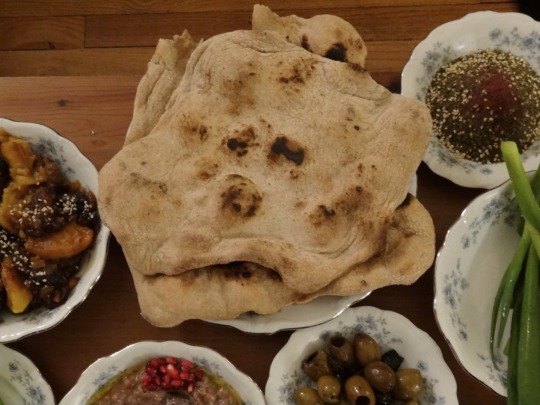
[ID: A plate of light brown bumpy flatbread with blackened spots, surrounded by za'tar and green olives. End ID]
خبز طابون / Khobz taboon (Palestinian flatbread)
Khobz taboon ("taboon bread") is a soft, chewy Palestinian flatbread. It may be eaten with olive oil and za'tar, but it is best known as the base of مسخن (musakhkhan), where it is topped with spiced aromatics and perhaps chicken.
Khobz taboon gets its name from the vessel it is traditionally cooked in—an outdoor, shallow conical oven with an opening at the top and a clay or metal cover to trap heat. Taboons may also have an opening at the side through which the fire can be stoked, especially in the east of Palestine. These ovens were historically made from a mixture of local clay and hay, but have more recently also been constructed from clay treated to be sturdier, or from metal.
A taboon is used by packing flammable material, such as hay, fabric, animal dung, wood, and charcoal, around the outside of the oven and letting it burn overnight; the fire transfers thermal energy to the clay, and to the river stones, sand, glass, or flint stones (صوان, "ṣawwān") that form the base of the oven. The ash is then brushed away, and the flattened dough is placed on the stones or stuck to the walls of the oven to cook. The clay and stones will continue to release thermal energy and cook things throughout the day. The clay and ash give a distinctive flavor to anything cooked inside the taboon, making this method a source of nostalgia for many people who have transitioned to cooking in indoor ovens.
Khobz taboon was traditionally made with whole wheat flour. Most people today use a blend of around two parts white flour to one part whole wheat, or else all white flour; they may even add milk or milk powder to ensure a very soft dough. This recipe uses a blend of flours to combine the nutty flavor of whole wheat dough with the pliancy of white dough. It also begins with an optional pre-ferment to mimic the traditional Palestinian method of including a piece of dough from the previous day's bread into each new batch (like a pâte fermentée) giving a rich and slightly sour flavor to the final bread. It calls for the use of rocks to imitate the bottom of a taboon; the rocks give the khobz its distinctive dimpled texture, and ensure that no interior pocket forms in the bread.
In the years following 2007, the siege Israel had imposed on Gaza caused a shortage of cooking gas that led to a resurgence in the use of taboons. The ovens were used to bake bread and to grill sweet potatoes during the time of their winter harvest. Meanwhile, in the West Bank, Israeli military forces repeatedly destroyed taboon ovens and assaulted villagers who tried to defend them, as Israeli settlers from nearby villages complained about the smoke that the ovens produced. Some of these ovens had been used to bake bread for entire families of 40 or more people. Palestinians continue to build, use, and defend these ovens, despite the fact that Israeli law de facto forbids Palestinians in the West Bank to build anything.
Today, Israel is deliberately targeting and destroying bakeries in refugee camps that had been supplying bread to tens of thousands of people in Gaza, continuing a long campaign of starvation of the Palestinian people.
Support Palestinian resistance by calling Elbit System's (Israel's primary weapons manufacturer) landlord; and donating to Palestine Action's bail fund.
Equipment:
A large, shallow mixing bowl, like a Moroccan qus'a
A large (12"), shallow clay cooking vessel, such as the bottom of a Moroccan tajine (one that is rated for very high temperatures), or a large baking tray
Assorted smooth river rocks of varying sizes, from 1 to 3" in diameter.
Make sure that your rocks have been thoroughly cleaned, and that they do not contain any fissures, cracks, or veins that could contain water (this water, once heated in the oven, could cause the rocks to crack open). Instead of river rocks, I used lava rocks designed for use in a clay tanoor. You just need something to provide thermal mass and give a bumpy texture.
Ingredients:
Makes 3 large breads.
For the pre-ferment:
140g whole wheat flour
1/2 tsp active dry yeast
140g water
You may also use a pâte fermentée that you already have (just adjust the ratio of white to whole wheat flour added later accordingly), or a sourdough starter. The hydration of the starter doesn't matter, since you will be adding water by eye later.
For the bread:
330g bread flour or all-purpose flour
30g whole wheat flour
5g salt
Water
If you skipped the pâte fermentée step, add 170g (rather than 30g) of wheat flour at this stage, as well as 1/2 Tbsp of active dry yeast. I have not tested the recipe this way.
Instructions:
For the pâte fermentée:
1. Mix flour and yeast in a small mixing bowl. Add water and stir to combine. Cover and leave out at room temperature for a day, or in the refrigerator for up to three days. At the end of the rising time, it should be about one and a half times its original size.
For the bread:
This recipe makes a high hydration dough that will need techniques such as slapping and folding to knead effectively.
1. Mix flours and salt in a very large, shallow mixing bowl. Add your pâte fermentée and mix to combine.
2. Add water until the flour comes together into a soft, sticky dough and continue keading. Have a bowl of water on your workstation. Every time the dough starts to stick to your hands or the sides of the bowl, wet your hands and rinse down the side of the bowl with some water. This will gradually add water to the dough.

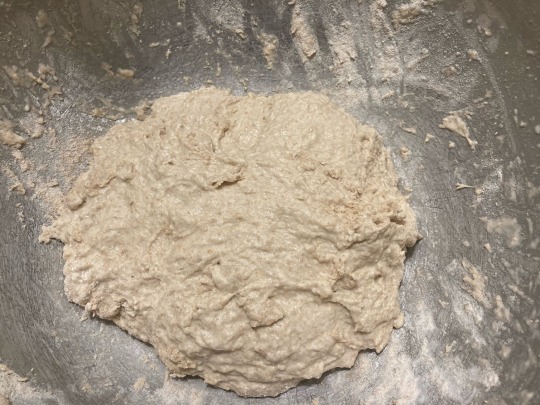
3. You will notice the dough growing smoother and laxer. At this point, start kneading by repeatedly folding the edges of the dough in towards the center. Do this by occasionally wetting your hands, then running a hand along the side of the bowl and under the edge of the dough to unstick it from the bowl; then fold. You will get stuck less often if you try to touch the dough as lightly and briefly as possible. Every few folds, dimple the surface of the dough all over with your fingertips. You will have been kneading for about 10 minutes at this point.
The dough should become more smooth and less bumpy—you will notice it holding its shape and becoming more stretchy as gluten forms. It should form into a ball when you fold the corners in and hold its shape for a minute, but then gradually expand to take the shape of the bowl. I added about 2 1/2 cups of water total (in dry conditions) during steps 2 and 3.
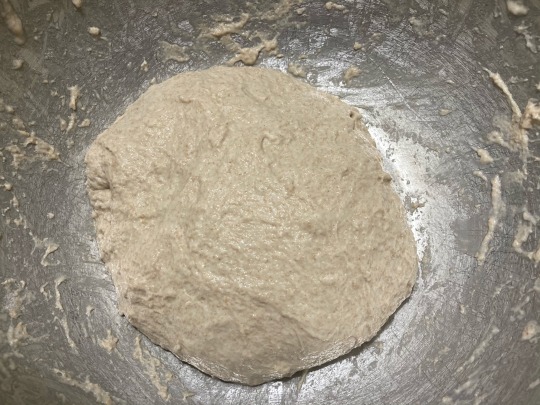
4. At this point, the dough is wet enough that the slap and fold method is the best way to knead. Wet your hands and again unstick the dough from the sides of the bowl. Hook your hands under the dough and quickly pull it all up into the air; fold the hanging bottom part of the dough under, and plop the dough back down, folding it on top of the part you plopped down earlier. Give the bowl a quarter turn and repeat. Do this continually for another few minutes.

5. When the dough is very smooth and lax, smear some olive oil on the sides of the bowl and under the dough, and pat some oil on top.
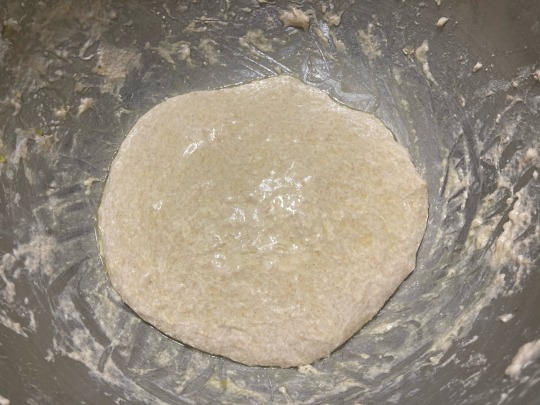
6. Cover the bowl and bulk ferment the dough at room temperature for 8 hours, or for 16-24 hours in the fridge. At the end of the rising time, you should see bubbles beginning to form on the surface of the dough.
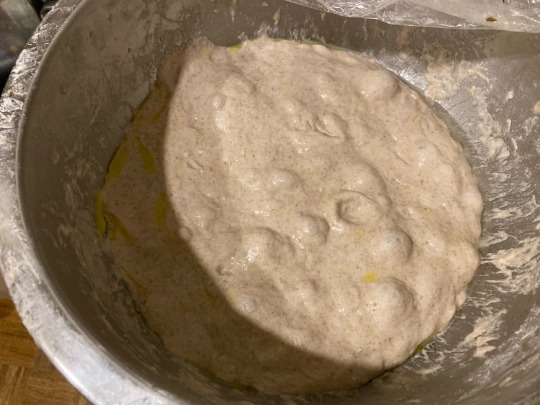
To shape and bake:
1. Place a layer of rocks at the bottom of a clay cooking vessel or baking sheet. Put the sheet in the top third of the oven and preheat your oven to 550 °F (290 °C), or as hot as it will go.
2. Meanwhile, fold the edges of the risen dough over into the middle a few more times with damp hands. Pinch off a large piece of dough (about the size of two fists), and fold the sides over into the middle to make a neat packet.
3. Drop the packet of dough onto a heavily floured surface, and flip to flour both sides. Pat the dough flat, then throw it back and forth between your hands, catching the edge each time as you spin it through the air, like a pizza crust, to stretch it into a circle about 1/4" (1/2cm) thick with a diameter of about 10" (25cm).
You may also stretch and pat the dough out on a flat surface.
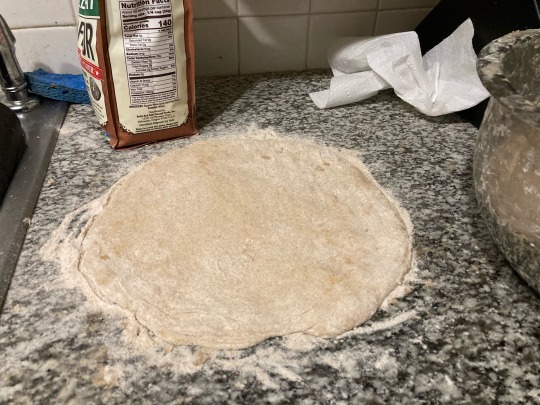
4. Remove the tray from the oven. Flip the dough circle over the back of your hand to transfer it and lay it down over the hot rocks. Re-stretch it into a circle, if necessary.
5. Place the tray back in the oven and cook for 5-7 minutes, until the top of the bread has golden brown spots. Repeat with each piece of dough, leaving the rocks in the oven for a few minutes between each one to allow them to come back up to temperature.
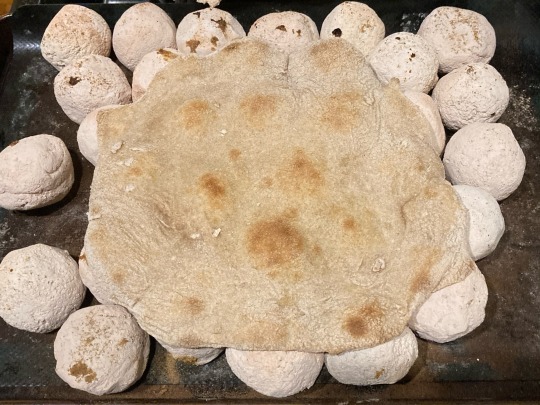
6. (Optional): Hold each flatbread directly over a gas flame for a minute or two to blacken a few spots and mimic the flavor that a wood-fired oven would give to your khobz.
You may also use a method similar to the dhungar technique to smoke your bread. Place each piece of bread one at a time into a large vessel with a closely fitting lid, alongside a small bowl. Light a piece of wood on fire and drop it into the bowl; then cover the vessel with the lid as you allow the wood to smoke for a minute or two.
#note that I do not recommend this recipe to anyone who is not experienced with making bread#I'll have another Palestinian flatbread recipe up soon which will be more beginner-friendly#Palestinian#bread#khobz#flatbread
341 notes
·
View notes
Text


Spirit of Morocco
Hi guys! The following post has been made by Mirai on her Patreon page, who asked me if I can share it from her name on Tumblr to gather more views, since she is having troubles with Tumblr recently:
Hello guys! I hope you are doing well! I know I have been a little quiet lately because I had to be hospitalized routinely again at the end of last month because of my autoimmune disorders, but everything is fine. However, I did hear about the earthquake in Marocco at the beginning of the month and I am heartbroken. I had the privilege to visit this magical country at the beginning of this year, and I fell in love immediately with their rich culture, fantastic food, beautiful sights, and friendly people. And that's why I wanted to do something.
I've been working really hard with no break since the day I heard about the event to make sure I can create as many items as possible. So I present to you 'Spirit of Marocco' a food kit filled with some of the most emblematic dishes from Moroccan cuisine. In total contains 13 different dishes and 5 canned goods.
All typical for Moroccan cuisine. - Three types of couscous dishes, four types of tajine dishes, Pastilla, Seffa, Mrouzia, Harira, Chebakya.
All canned goods require Cottage Living EP*
All dishes require the latest version of my food enabler
Until the 30th of October, you can purchase this custom food set 'Spirit of Morocco' on the Ko-Fi platform, and all collected money there will be donated to Morocco Earthquake Relief Fund by GlobalGiving:
Of course, the set will also be uploaded on my Patreon, to honor all the people who support me monthly, but if you want your money to go towards the charity, make sure to download the set from my Ko-Fi shop.
Ko-Fi Shop
Mirai's Patreon
How to help Morocco:
Thank you and happy Simming!
Mirai M ~
THE FOOD IN GAME**


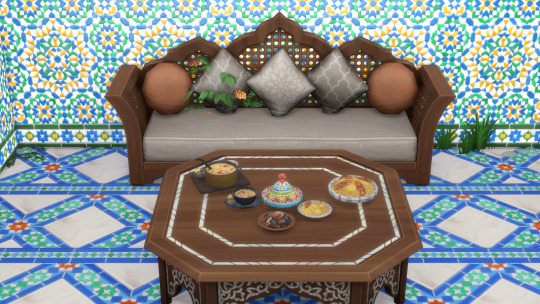

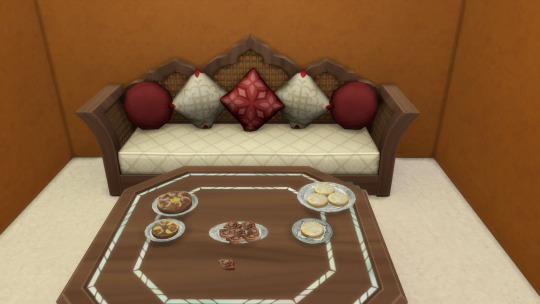
@maxismatchccworld @sssvitlanz @scarlets-realm @luthsthings
#ts4 custom content#s4 download#ts4 download#s4 custom content#ts4 maxis match#ts4 maxis mix#s4 maxis match#sims 4 download#s4 mm cc#ts4 mm cc#ts4 custom food#ts4 custom drink#ts4 custom objects#ts4 custom recipe#ts4 custom recipes#s4 custom food#s4 custom drink#s4 custom object#s4 custom drinks#sims 4 custom food#sims 4 custom content#sims 4 custom recipes#ts4 maxis cc#ts4 alpha mix#ts4 alpha
91 notes
·
View notes
Text
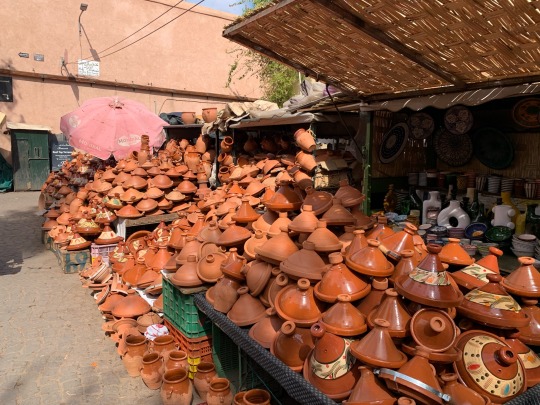
Tajin
0 notes
Text
[...] Ms. Zkik explained that Plug-in [a company hired to translate and voice act dubbings of foreign films and television into Moroccan Arabic] was not entirely free in the choice of language it used in dubbing in Moroccan Arabic. Ismail, a voice actor at Plug-in who I met on one of my visits, explained to me that during the first year he began dubbing at Plug-in there were specific guidelines from their client, the broadcasting station 2M, regarding register and lexical choice. For example, during recordings he said that he had been specifically told not to use the word “tomobil”[,] a frequently used word for ‘car’[,] because it was a clear French borrowing. The term “siya:ra” [سيارة] ‘car’ was preferred due to its Standard Arabic origin. Ismail interpreted these guidelines as both a desire by 2M to create a truly “Moroccan” dubbing in that linguistic reminders of a French colonial influence had been minimized. He also saw it as a nod to viewers who use other varieties of Arabic and who may not understand French borrowings into Moroccan Arabic.
— Jennifer Lee Hall, Debating Darija: Language Ideology and the Written Representation of Moroccan Arabic in Morocco (PhD dissertation), 2015, pp. 76-9.
(the "during recordings" is misplaced—Hall means that Ismail was not to use the word "tomobil" while recording dubs, not that he communicated this to her during said recordings)
this is really interesting to me. the presence of French (and, to a lesser extent, Spanish) borrowings is a distinctive feature of Moroccan Darija, especially that of the northern cities, and one that most speakers of other varieties of Arabic would know to associate with Morocco. I've heard people associate it more with Moroccan Darija than with e.g. Algerian or Tunisian, even (tho' this is an association, not something that I've sought to substantiate empirically).
Tajine Qui Parle only lists طُموبيلة "Tomobila" and طُموبيل "Tomobil" for "voiture" ("car"); wiktionary indicates that سيارة "car" is used in Standard, Kuwaiti Gulf, and Moroccan Arabic (with expected differences in pronounciation), and also gives a couple different possible spellings for طمبيل "Tomobil" (which it lists as a word only in "Moroccan Arabic"); it gives سيارة ("siyyaara") as a Moroccan Arabic word, but notes that it is "uncommon."
the idea that a word of Standard Arabic origin is automatically "more Moroccan" than a word of French origin, despite that fact that as far as I can tell "Tomobil" is more distinctively Moroccan, is on its surface kind of bizarre, but it makes sense when you consider the recent colonial underpinnings of French borrowings into Moroccan Arabic. the post-colonial process of Arabisation is a process of nationalisation, of creating a national myth around (the repression of Amazigh identity and communist movements in favour of) a desired "Islamic" "Arab-ness"—which is, however, like Frenchness, a language and culture that was introduced or imposed on North Africa and is not "original" to it (not that any culture is completely "original" and free from shifting or borrowings!—rather that the "originality" of Arabic to Morocco seems to be a myth that is being drawn on here).
given that shows dubbed in Moroccan Arabic are to teach the public "good" spoken Darija, they can be analysed in terms of how the ethos of Arabisation connects education with nation: "generaliz[ing] the Arabic language" in order to both "democratiz[e] access to education and affirm[] the Arab identity of the Kingdom" (Youssef Sourgo, Morocco World News). and Arabisation also, of course, paradoxically relies on looking outside Morocco in order to institute Morocco's "Moroccanization":
After its independence, Morocco could not yet aspire to a successful arabization with the lack of professors of Arabic in the kingdom. To remedy this problem, Morocco hired professors from other countries, such as Egypt, Syria and Sudan. (ibid.)
it seems pertinent that, in a discussion about Arabisation, I once heard someone state that the removal of French from buildings and other public spaces was "good," and then also share with me a personal, familial myth that their family, like "all Arabs," had "come from the Middle East" (I think these are direct quotes from a conversation that took place in English?)
it should also be mentioned that words of Standard Arabic origin may be preferred even if the alternative is not (so far as I can tell) a European borrowing: Hall recounts one Moroccan woman noting approvingly that a dubbed Mexican show depicted a married woman who '“properly” referred to her mother-in-law as ‘ḥma:ti’ [حماتي]* instead of as ‘ʻduza’ [عدوزة] or worse ‘ʻguza’ [عݣوزة],' which latter two words the woman associated with 'a rural background and lack of education' (pp. 203-4). it's furthermore interesting to me that she described عݣوزة as "worse" than a word that's identical except for its inclusion of the gaf (ݣ; /g/; hard "g" sound), given that gaf is not in the Standard Arabic abjad, while dal (د; /d/) is!
*حما hma "in-law" (+ ة -a [singular feminine marker], which is then removed when the possessive is added) + تي -ty [1st-person singular possessive marker for a word ending in ة].
19 notes
·
View notes
Photo

I bought some minced lamb last week with an eye to BBQ during incoming hot weather, but the weather turned out so hot enough that standing over glowing charcoal didn’t appeal. In addition the horseflies were especially rambunctious; I swatted three off me in the couple of minutes I was checking the outdoor temperature and deciding Nope, too hot.
Eating food outside is fine, being fed on outside, not so good.
*****
So the other night I used it to throw together this Lamb Kofte Tajine, a vaguely North African version of meatballs in tomato sauce. “Throw together” is accurate, I winged it without consulting any books or recipes and even the cooking procedure is highly inauthentic; far too fast for one thing. It worked, though, and was very good.
(The last time was an Indian-influenced treatment: more slowly cooked, just as vague, just as good.)
Putting already-minced meat in a food processor may seem excessive; however there’s a good reason when making kofte / kofta / kufteh (etc.). These are North African / Middle Eastern / Indian meatballs, the original word means “pounded”, and processing recreates a very fine pestle-and-mortar texture which holds together without assistance from egg or breadcrumbs.
*****
A vegetarian version could simply replace the meat meatballs with lentil ones; there are plenty of recipes online including Moroccan-style. I also think this would work splendidly using falafel; they might not keep the crunch of freshly fried ones, but they’ll have the same crust and mouthfeel as the grilled kofte.
This was even good cold, not that there was much left. I plan to remake the basic sauce then boost it with harissa (Tunisian chilli relish) or zhoug (Yemeni coriander relish) to see if it makes as good a dip as my imagination suggests. That imagination is also suggesting not just home-made pita bread to dip in it, but pita cut into strips and fried in olive oil so it stays crunchy.
Yum...
*****
Anyway, here’s how to make the sorta-kinda-tajine.
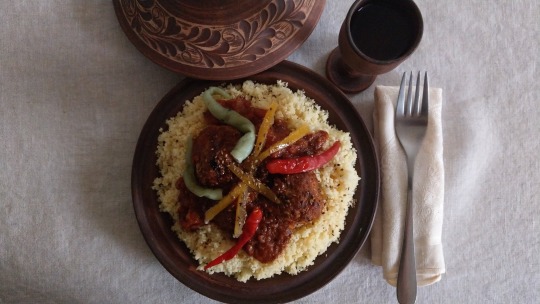
Sauce
1 onion, chopped finely
2-4 cloves of garlic, chopped finely
50 ml olive oil
1 tsp allspice
1 tsp chilli
1 tsp cinnamon
1 tsp cumin
1 tsp ginger
1 tsp paprika
½ tsp cloves
Two 400 g tins of chopped tomatoes
Kofte
500 g minced lamb
2 tsp black pepper
1 tsp cumin
1 tsp mint
300 g couscous
1 small or ½ large preserved lemon, chopped finely (If unavailable, use 2 Tbsp lemon juice and 1 tsp salt)
Method:
Heat the olive oil in a pan and sauté the onion and garlic until soft. Add the dry spices and stir fry for a minute. Add tomatoes and simmer for about 10-15 minutes. while preparing the meatballs.
Turn the grill (broiler) full on and preheat.
Put the minced lamb and its dry spices in a food processor and whizz until well combined. Form into meatballs; 500g of minced meat should become 8 of about golf-ball size.
Put the meatballs on the grill rack and brown on all sides, then transfer to the sauce and simmer gently, uncovered, for about 15 minutes while preparing the couscous as per packet instructions.
If there are none, put the couscous in a saucepan and cover with boiling water, stir, and put on a lid. Leave for five minutes, check for tenderness and re-lid for longer if need be, otherwise fluff up with a fork.
Remove the sauce and meatballs from the heat, stir in the chopped preserved lemon and serve on a bed of couscous. The sauce should be thick, fragrant, tangy but not hot.
For heat, use harissa or zhoug. These are usually sold as jars of salsa-like paste, so stir 2 Tbsp of relish into 2 Tbsp of EV olive oil and set it out in a small bowl with a spoon. (NB, heat varies with brand, so taste-test before use!)
*****
When I plated up, I got fancy with some pickled chillis, a couple of strips of preserved lemon peel and a sprinkle of toasted sesame seeds.
Not absolutely necessary, but certainly photogenic...

46 notes
·
View notes